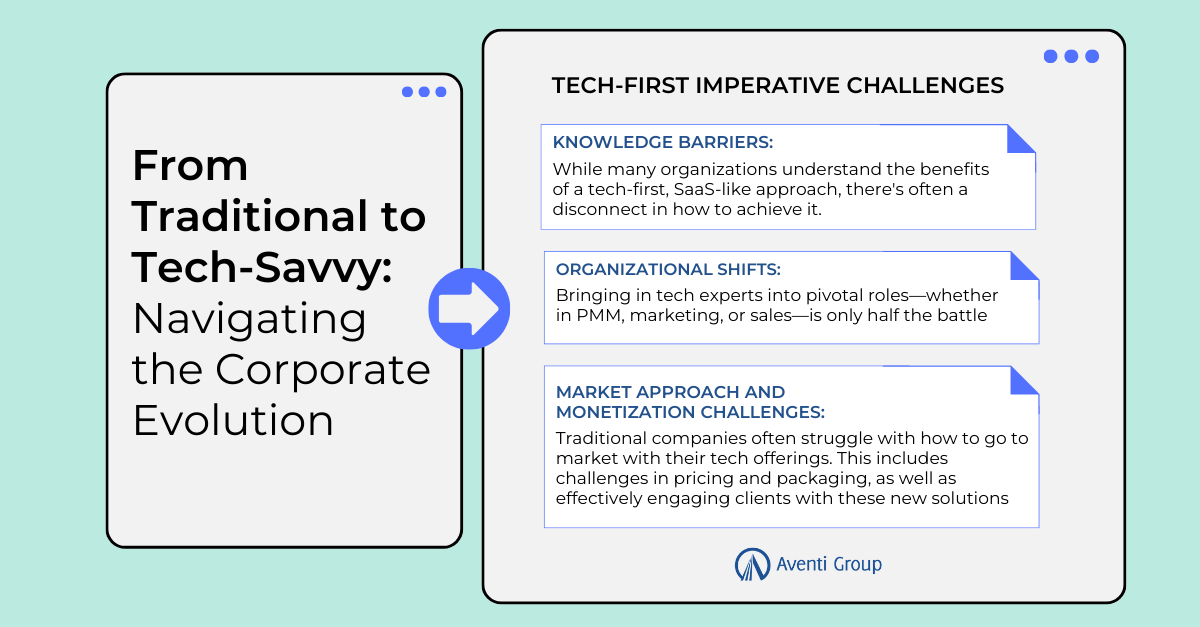From Traditional to Tech-Savvy: Navigating the Corporate Evolution
Mastering the Tech Pivot: A Roadmap for Traditional Businesses Evolving into Tech-First Enterprises
In today’s dynamic business environment, the influence of technology is undeniable. Every sector, whether manufacturing stalwarts or finance giants, faces a pivotal choice: maintain their traditional methodologies or adapt and become a tech-first entity? The allure of this shift lies in its promise: greater valuations, market dominance, and a forward-facing position. However, evolving from a conventional model to embrace the nuances of a SaaS-centric approach is not without its complexities and challenges. Let’s take a look at what those look like and how best to navigate them on the path to tech transformation.

Understanding the Tech-First Imperative
In today’s business landscape, it’s not merely about having technological capabilities––it’s about leveraging them strategically to differentiate, innovate, and outpace competitors. The distinction between a tech-aware company and a tech-driven one can significantly impact valuations and market dominance.
Research from Deloitte highlights this, showing that when technology is closely aligned with a company’s strategy, the valuation impact can be twice as high compared to digital strategy alone. Furthermore, the right combination of digital strategies and technology alignment can potentially unlock an additional US$1.25 trillion in market capitalization across Fortune 500 companies. This shift underscores the profound financial benefits of evolving into a tech-forward enterprise. Yet there’s more to it than just integrating the latest software: the aim is to become a truly tech-enabled entity, placing technology at the heart of every strategy and solution.
Yet, this transition presents challenges:
- Knowledge barriers: While many organizations understand the benefits of a tech-first, SaaS-like approach, there’s often a disconnect in how to achieve it. The end goal is clear, but the path remains elusive.
- Organizational shifts: Bringing in tech experts into pivotal roles—whether in PMM, marketing, or sales—is only half the battle. Without the freedom to act as change catalysts, their potential remains untapped.
- Market approach and monetization challenges: Traditional companies often struggle with how to go to market with their tech offerings. This includes challenges in pricing and packaging, as well as effectively engaging clients with these new solutions. Unlike in tech-driven companies, where technology products are the core offering, in traditional setups, tech solutions are frequently treated as ancillary, often bundled as add-ons rather than monetized effectively. This lack of a strategic approach to marketing and monetizing tech can significantly impede the realization of its full value.
As we explore this transformation further, we’ll delve into the intricacies of redefining strategies, glean some insights from real-world B2C examples, and seek guidance from thought leaders. The objective is to provide a clear blueprint for traditional companies eager to transition and thrive in the tech-dominated future.
The Dual Focus of Tech Launches
It’s worth noting a key distinction in tech transitions: the importance of balanced launches. Every tech product launch is not just about creating a splash in the market with external marketing. There’s an equally vital, arguably even more crucial, component: internal launch strategies. Ensuring that every team member, from sales to customer support, understands the product, believes in its value, and is equipped to communicate its benefits is foundational. The most successful tech transitions recognize this and allocate resources and emphasis accordingly, ensuring that the buzz and alignment come from within just as powerfully as they’re projected outwards.
With this balanced approach in mind, let’s delve deeper into some real-life companies that have navigated this landscape–some successfully, others with mixed results.
B2C Examples: The Successes, the Stumbles, and the Pivots
McDonald’s and Dynamic Yield:
McDonald’s, known globally for its fast food, took a major step into the tech realm by acquiring Dynamic Yield in 2019. The goal? To leverage the company’s AI-driven technology to personalize the drive-thru experience. By using real-time data like current weather conditions, time of day, and trending menu items, the drive-thru menu displays can be dynamically adjusted to promote certain items, ideally leading to increased sales. It was an ambitious move to combine quick-service dining with cutting-edge tech, showcasing how even the most traditional industries can integrate modern solutions to enhance customer experience.
Lululemon and Mirror:
In a bid to tap into the growing realm of connected fitness, Lululemon acquired Mirror—a startup offering a tech-laden mirror that doubles as a personal workout screen. The initial excitement suggested a future where Lululemon could merge its athletic wear with tech-infused workouts.
However, the acquisition didn’t pan out as hoped. Despite the potential, Lululemon faced significant challenges integrating Mirror both “operationally, culturally, and from a sales perspective.” It also proved difficult to seamlessly align the two brands. The result: earnings soon showed that the $500m acquisition was essentially worthless.
Recently, Lululemon decided to discontinue Mirror, reflecting a strategic shift away from hardware sales. In a move to maintain their presence in the digital fitness landscape, however, they have forged a five-year partnership with Peloton. This collaboration will focus on content sharing and co-branded apparel, marking Lululemon’s continued pursuit of tech-enabled fitness solutions, albeit through a different approach.
Nike’s Tech Transformation:
Nike, the athletic wear behemoth, has long been on the frontier of merging tech with sportswear. But recent moves indicate an even stronger pivot. Declaring itself a tech company, Nike has ventured into areas like app-driven sales, AR-driven shopping experiences, and data-driven personalized products. Their commitment to this tech-forward approach was solidified with the appointment of a tech executive as their next CEO—a clear sign that Nike envisions its future at the intersection of tech and athletic wear.
B2B Example: Adobe’s Transition to the Cloud
In the realm of B2B digital transformations, Adobe offers a compelling example. Per Accenture, which observed positive growth and revenue results in the 8% of companies surveyed that have transitioned to being tech-savvy, Adobe exemplifies this trend exceptionally well.
Adobe, initially renowned for its licensed software products like Photoshop and Acrobat, faced a critical juncture when it decided to shift from traditional software sales to a cloud-based subscription model in 2013. This move to Adobe Creative Cloud represented a significant risk but was driven by foresight into evolving market demands and technological trends.
The transformation involved not just a change in product delivery but a complete overhaul of Adobe’s business model. It required reimagining their entire product suite as a service (SaaS), focusing on continuous updates, cloud storage, and integrating AI-driven tools to enhance user experience and capabilities. This pivot to a subscription-based model resonated strongly with its customer base, leading to a substantial increase in recurring revenue and a more sustainable, predictable business model.
Furthermore, Adobe’s foray into digital marketing software with Adobe Experience Cloud has positioned it as a key player in digital experience management, catering to a broad B2B audience. This expansion demonstrated Adobe’s commitment to staying ahead in the digital curve, transforming itself from a software manufacturer to a comprehensive digital solutions provider.
Adobe’s successful transition not only led to significant revenue growth but also reinforced its position as an innovator in the digital space. This journey from traditional software licensing to a cloud-based subscription model highlights the strategic foresight and adaptability that can drive success in today’s tech-savvy business environment.
Pivoting to Tech: A Holistic Evolution
The journey from a traditional framework to a tech-savvy model is neither linear nor guaranteed. However, the potential rewards, from elevated market valuation to increased consumer engagement, make it a compelling choice.
As the B2C examples above demonstrate, the path to tech transformation is essentially a crash course in GTM strategy. Success hinges on more than just adopting tech solutions—it’s about mastering product launches, crafting compelling narratives, and reimagining sales and marketing approaches.
The pivot to tech isn’t just a change—it’s a holistic evolution of the entire GTM process, demanding both inward and outward alignment for genuine success.
Ready to transform your business into a tech-savvy powerhouse? At Aventi Group, we understand the intricate journey of transitioning to a tech-first model. Our expertise can significantly impact how you launch products, tell your brand story, enable your sales team, position against competitors, and market effectively in this digital era.
Embrace the change with Aventi Group. Let us guide you in mastering these critical aspects, paving the way for a successful and innovative future. Contact us today to start your transformation journey.





